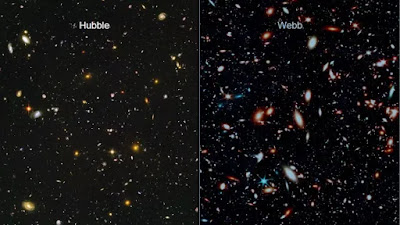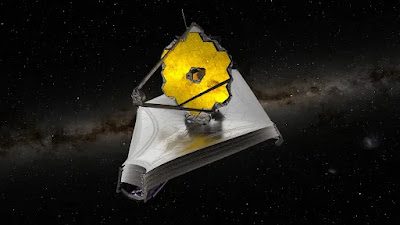The James Webb Space Telescope Will Change Our View Of The Universe - Current Affairs 2022 for APSC Mains Exam
The James Webb Space Telescope is the next-generation space observatory succeeding the Hubble Space Telescope. It is designed to unlock the answer to unsettled questions about our Universe. It will dive deeper into our origins and possible future. A concise and consistent picture will be derived about the creation of planets and stars and the birth of the primordial galaxies in the early stages of the Universe. Webb will churn out incredible discoveries in every field of astronomy and astrophysics.
It will also analyse far away potentially habitable planets and other cosmic events. The main goal of JWST is to surpass the range of the Hubble Telescope.
It is named after a NASA administrator (James E. Webb) who headed the Apollo, Gemini and Mercury missions (1961-1968).
First Full-color Images From The James Webb Space Telescope
NASA Invites World to "Glow Golden" for Webb Telescope’s First Images
NASA is inviting the public to take part in virtual activities and events as NASA celebrate the James Webb Space Telescope’s release of its first images. NASA, in partnership with ESA (European Space Agency) and CSA (Canadian Space Agency), will release the full set of Webb’s first full-color images and spectroscopic data during a televised broadcast beginning at 10:30 a.m. EDT on Tuesday, July 12, from NASA’s Goddard Space Flight Center in Greenbelt, Maryland.
Released one by one, these first images from the world’s largest and most powerful space telescope will demonstrate Webb at its full power, ready to begin its mission to unfold the infrared universe.
James Webb Space Telescope
Image credit: NASA, ESA, CSA, and STScI
Each image will simultaneously be made available on social media as well as on the agency’s website at: nasa.gov/webbfirstimages
President Biden Reveals First Image from NASA’s Webb Telescope
President Joe Biden released the first full-color image from NASA’s James Webb Space Telescope Monday, during a public event at the White House in Washington. This first image showcases the powerful capabilities of the Webb mission, a partnership with ESA (European Space Agency) and CSA (Canadian Space Agency).
“These images are going to remind the world that America can do big things, and remind the American people – especially our children – that there’s nothing beyond our capacity,” said President Biden in remarks during the event. “We can see possibilities no one has ever seen before. We can go places no one has ever gone before.”
Webb’s first full-color image reveals thousands of galaxies, including the faintest objects ever observed in the infrared.
"Webb's First Deep Field is not only the first full-color image from the James Webb Space Telescope, it’s the deepest and sharpest infrared image of the distant universe, so far. This image covers a patch of sky approximately the size of a grain of sand held at arm’s length. It’s just a tiny sliver of the vast universe," said NASA Administrator Bill Nelson. “This mission was made possible by human ingenuity – the incredible NASA Webb team and our international partners at the European Space Agency and the Canadian Space Agency. Webb is just the start of what we can accomplish in the future when we work together for the benefit of humanity."
This record-setting deep field provides a preview of the full set of Webb’s first images, which will be released at 10:30 a.m. EDT Tuesday, July 12, in a live broadcast on NASA Television. The images will be available at:
https://www.nasa.gov/webbfirstimages
NASA’s Webb Delivers Deepest Infrared Image of Universe Yet
NASA’s James Webb Space Telescope has produced the deepest and sharpest infrared image of the distant universe to date. Known as Webb’s First Deep Field, this image of galaxy cluster SMACS 0723 is overflowing with detail.
The James Webb Space Telescope is the world's premier space science observatory. Webb will solve mysteries in our solar system, look beyond to distant worlds around other stars, and probe the mysterious structures and origins of our universe and our place in it. Webb launched Dec. 25, 2021, on an Ariane 5 rocket from Europe’s Spaceport in French Guiana, South America. After completing a complex deployment sequence in space, Webb underwent months of commissioning where its mirrors were aligned, and its instruments were prepared for science.
Thousands of galaxies – including the faintest objects ever observed in the infrared – have appeared in Webb’s view for the first time. This slice of the vast universe covers a patch of sky approximately the size of a grain of sand held at arm’s length by someone on the ground.
This deep field, taken by Webb’s Near-Infrared Camera (NIRCam), is a composite made from images at different wavelengths, totaling 12.5 hours – achieving depths at infrared wavelengths beyond the Hubble Space Telescope’s deepest fields, which took weeks.
The image shows the galaxy cluster SMACS 0723 as it appeared 4.6 billion years ago. The combined mass of this galaxy cluster acts as a gravitational lens, magnifying much more distant galaxies behind it. Webb’s NIRCam has brought those distant galaxies into sharp focus – they have tiny, faint structures that have never been seen before, including star clusters and diffuse features. Researchers will soon begin to learn more about the galaxies’ masses, ages, histories, and compositions, as Webb seeks the earliest galaxies in the universe.
This image is among the telescope’s first-full color images. The full suite will be released Tuesday, July 12, beginning at 10:30 a.m. EDT, during a live NASA TV broadcast. Learn more about how to watch.
The James Webb Space Telescope is the world's premier space science observatory. Webb will solve mysteries in our solar system, look beyond to distant worlds around other stars, and probe the mysterious structures and origins of our universe and our place in it. Webb is an international program led by NASA with its partners, ESA (European Space Agency) and CSA (Canadian Space Agency).
NASA Headquarters oversees the mission for the agency’s Science Mission Directorate. NASA’s Goddard Space Flight Center in Greenbelt, Maryland, manages Webb for the agency and oversees work on the mission performed by the Space Telescope Science Institute, Northrop Grumman, and other mission partners. In addition to Goddard, several NASA centers contributed to the project, including the agency’s Johnson Space Center in Houston; Jet Propulsion Laboratory (JPL) in Southern California; Marshall Space Flight Center in Huntsville, Alabama; Ames Research Center in California’s Silicon Valley; and others.
NIRCam was built by a team at the University of Arizona and Lockheed Martin’s Advanced Technology Center.
Now World_Polity is on every platform you can connect with us by just clicking the below social media links. Thank You.
• Subscribe our Youtube channel
• Join our Facebook Page
• Join our telegram Channel
* Recent Top Most Searches :
• Top 20 Most Popular Inventors of the World
Well if you like this article on Nasa’s James Webb Space Telescope Should Open A New Window On The Early Universe | The James Webb Space Telescope APSC, do comment & show your support by sharing it to the others and if there is any query you are welcome to ask.
















0 Comments
(Please do not enter any spam link in the comment box)